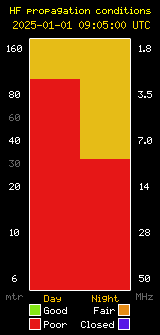News
- Details
- Written by: Maintenance Guy
- Category: News
- Hits: 530
Build a working FM radio in 24 steps!
Merv M0WVE has committed to complete this project day by day during December and post the experimental results of each sub-project on our Facebook page. I'd buy that for a dollar (approx 50p GBP).
- Details
- Written by: Maintenance Guy
- Category: News
- Hits: 704
Going once. Going twice...

Some professional-level auction room deportment was clearly in evidence at last week's Surplus Equipment Sale, with Chief Auctioneer Chris M1CSE, ably assisted by Peter G4AKG working their way through a bumper collection of both radio and non-radio related goodies.

Numbers were noticeably down this year, several members being extra-cautious with regard to the blasted virus whose name we shall not mention, but I have to tell you that those that did show up snagged some ridiculous bargains. These included a working (or at least it is now...) Yaesu FT101 for a fiver. I may have got that horribly wrong, but I don't think so! Other lots were going for silly money too, like 50p or £1. A shame in some ways, but the society more than covered its costs, sellers got shot of stuff they no longer needed, and a whole load or hardware got recycled, which has got to be a good thing.
Attendees were also treated to freshly-prepared food and drink, and it was (as you can see) served with a smile. I think that price list was recycled from the 1970's... surely you can't buy a homemade cheese straw for 50p?

So in 2022, when we have our next junk sale, you'll know to get down there with a pocketful of cash. You wouldn't want to miss out a second time, right?
I'll not name everyone involved, but thanks go to all the helpers on the night, all the sellers for lugging your gear to the hall, and all the buyers for taking it away again. Thanks to Russell for supplying much of the junk and presiding over the raffle, and thanks also to Alan G8YKV who responded to my request for the photos in this article.
- Details
- Written by: Maintenance Guy
- Category: News
- Hits: 863
 Please come and support our 2021 Surplus Equipment Sale at Starford Hall (the upstairs room at Cyprus Hall) this Friday.
Please come and support our 2021 Surplus Equipment Sale at Starford Hall (the upstairs room at Cyprus Hall) this Friday.
All manner of rubbish to fill that last remaining space in your existing junk pile.
In fact, why don't you bring some of your old junk to swap for some new junk?
A 15% commission from each sale goes into club funds, and every little helps. Come hungry too, as food and drinks are available.
All the details are on our events page.
- Details
- Written by: Maintenance Guy
- Category: News
- Hits: 637
I use this website all the time to see if I need to drop my flimsy fibreglass masts onto the lawn due to extreme wind gusts, electrical storms etc. The menu on the right hand side gives you more data than the Pandora Papers. This link takes you straight to the Forecast for Burgess Hill.
Thought it was worth sharing.
Berni M0XYF
- Details
- Written by: Maintenance Guy
- Category: News
- Hits: 701
 This weekend, Friday 15th October thru Sunday 17th October is #JOTAJOTI weekend. If you are fairly new to radio, then it may not be immediately apparent what this is, so here are the highlights.
This weekend, Friday 15th October thru Sunday 17th October is #JOTAJOTI weekend. If you are fairly new to radio, then it may not be immediately apparent what this is, so here are the highlights.
Jamboree On The Air (JOTA) is an annual celebration of radio operation by the global Scouting family, and is a big deal for that organisation. It's a fantastic mix of camping, global campfires, live shows, fun challenges and of course assisted and supported radio communications for our young people around the world. It's educational and a lot of fun.
Of course, with the pandemic situation last year, the vast majority of social gathering was curtailed, but inventive and creative as both Scouts and radio amateurs are, that didn't stop JOTA 2020 from taking place. What happened was that radio links were supplemented with Internet links, relays and bridges, allowing keen future radio operators to carry on regardless. #JOTI really did save #JOTA in 2020!
This year, the digital communications theme has rightly continued and expanded, and together with more traditional radio operation now provides a hugely exciting platform for promoting all communications technology, the values of global citizenship, and young people's role in creating a better world. Make sure that if you are on air this weekend, you make some time to welcome the amateurs of tomorrow.




